heating CHEVROLET CORVETTE 1994 4.G Owners Manual
[x] Cancel search | Manufacturer: CHEVROLET, Model Year: 1994, Model line: CORVETTE, Model: CHEVROLET CORVETTE 1994 4.GPages: 274, PDF Size: 15.61 MB
Page 8 of 274
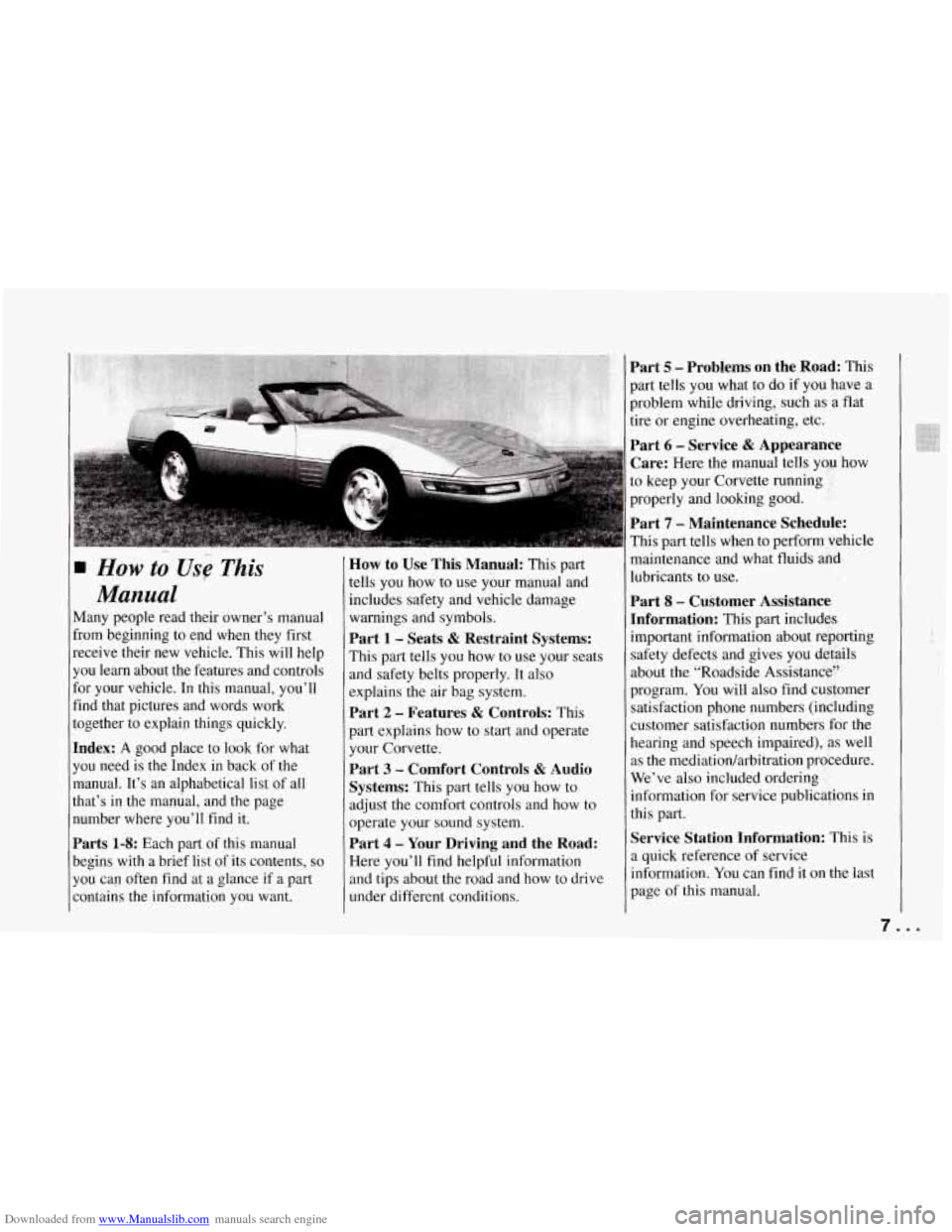
Downloaded from www.Manualslib.com manuals search engine How to Us; This
Manual
5.-
Many people read their owner’s manual
from beginning to end when they first
receive their new vehicle. This will help
you learn about the features and controls
for your vehicle.
In this manual, you’ll
find that pictures and words work
together to explain things quickly.
Index: A good place to look for what
you need is the In-dex in back of the
manual. It’s an alphabetical list of all
that’s iq the manual, and the page
number where you’ll find it.
Parts 1-8: Each part of this manual
begins with a brief list of its contents,
so
you cap often find at a glance if a part
Eontains the information you want.
How to Use This Manual: This part
tells you how to use your manual and
includes safety and vehicle damage
warnings and symbols.
Part 1 - Seats & Restraint Systems:
This part tells you how to use your seats
and safety belts properly. It also
explains the
air bag system.
Part 2 - Features & Controls: This
part explains how to start and operate
your Corvette.
Part 3 - Comfort Controls & Audio
Systems:
This ,part tells you how to
adjust the comfort controls and
how to
operate your sound system.
Part 4 - Your Driving and the Road:
Here you’ll find helpful information
and tips about the road and how to drive
under different conditions.
Part 5 - Problems on the Road: This
>art tells you what to do if you have a
Jroblem while driving, such as a flat
:ire or engine overheating, etc.
Part 6 - Service & Appearance
Care:
Here the manual tells yqap how
:o keep your Corvette running ’’:;’.
properly and looking good. ’,:.
Part 7 - Maintenance Schedule:
This part tells when to perfom,,vehicle
maintenance and what fluids
a&l
lubricants to use.
Part 8 - Customer Assistanc?
~nformation:
This part includ&
important information about rdiorting
safety defects and gives you &$$ls
about the “Roadside Assistancq?
program. You will also find cG$@mer
satisfaction phone numbers (ir&luding
customer satisfaction numbers .for the
hearing and speech impaired),
&s well
as the mediationhrbitration prokedure.
We’ve also included ordering
information for service publicagions in
this part.
Service Station Information: This is
a quick reference of service
information. You can find it
on the last
page of this manual.
..
I ‘I ,
7 I ...
Page 77 of 274
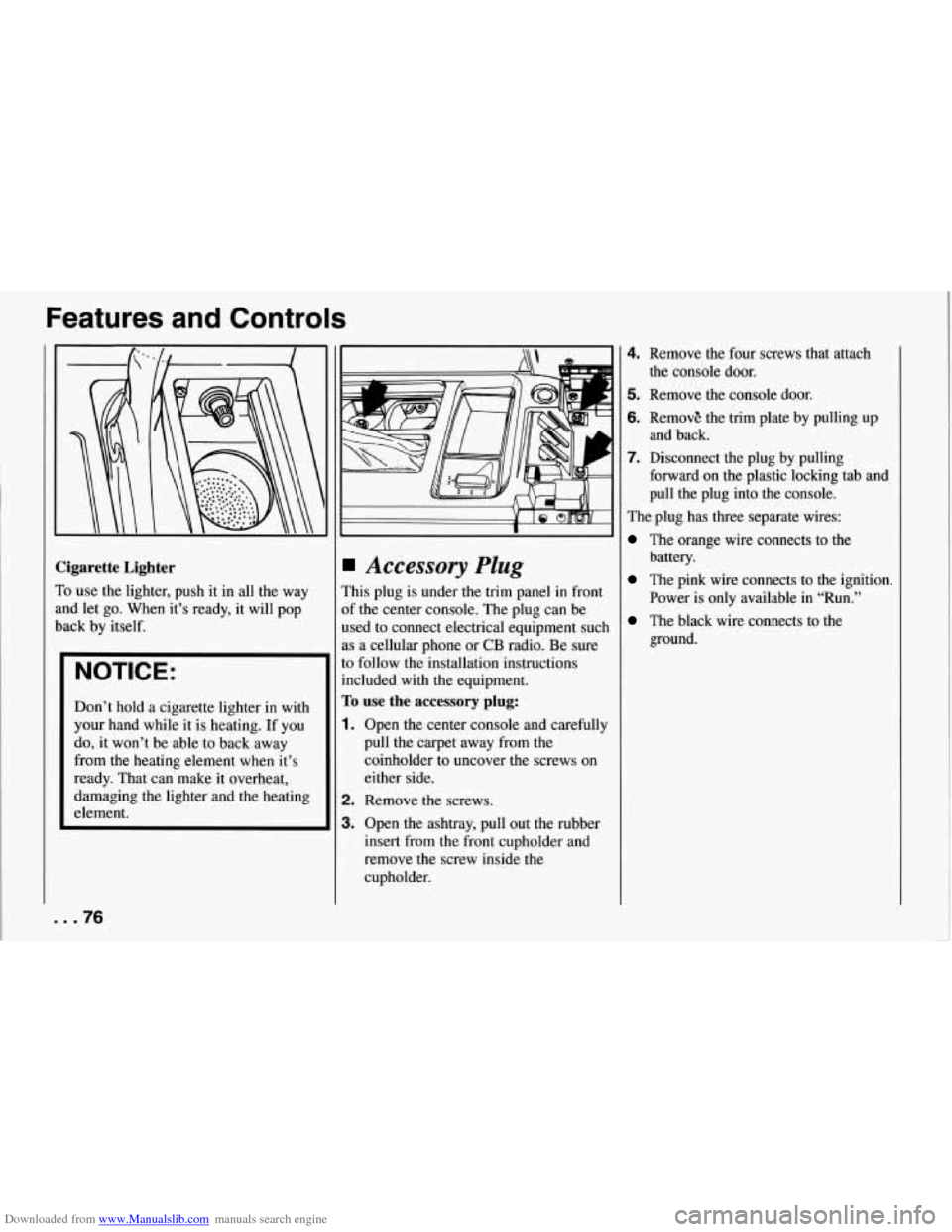
Downloaded from www.Manualslib.com manuals search engine Features and Controls
Cigarette Lighter
To use the lighter, push it in all the way
and let go. When it’s ready, it will pop
back by itself.
NOTICE:
Don’t hold a cigarette lighter in with
your hand while it is heating. If you
do, it won’t be able to back away
from the heating element when it’s
ready. That can make it overheat,
damaging the lighter and the heating
element.
Accessory Plug
This plug is under the trim panel in front
of the center console. The plug can be
used to connect electrical equipment such
as a cellular phone
or CB radio. Be sure
to follow the installation instructions
included with
the equipment.
To use the accessory plug:
1. Open the center console and carefully
pull the carpet away from the
coinholder to uncover the screws on
either side.
2. Remove the screws.
3. Open the ashtray, pull out the rubber
insert from the front cupholder and
remove the screw inside the
cupholder.
4. Remove the four screws that attach
5. Remove the console door.
6. RemovE the trim plate by pulling up
7. Disconnect the plug by pulling
the console door.
and back.
forward on the plastic locking tab and
pull the plug into the console.
The plug has three separate wires:
The orange wire connects to the
battery.
The pink wire connects to the ignition.
Power is only available in “Run.”
The black wire connects to the
ground.
... 76
Page 90 of 274
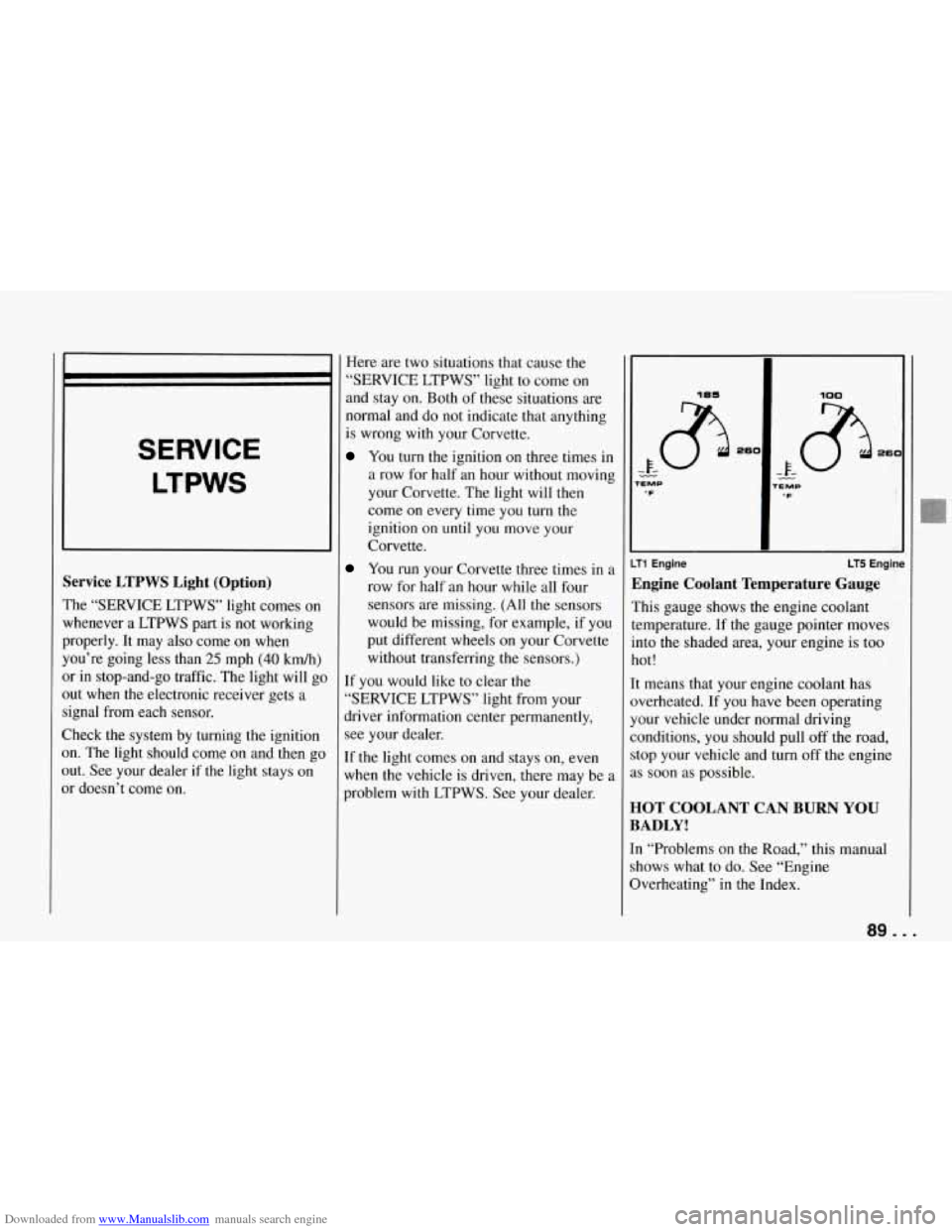
Downloaded from www.Manualslib.com manuals search engine I
S
T
P
Y
U
0
0
si
C
0:
01
SERVICE
LTPWS
‘ervice LTPWS Light (Option)
‘he “SERVICE LTPWS” light comes on
rhenever a LTPWS part is not working
roperly. It may also come on when
ou’re going less than
25 mph (40 kmk)
r in stop-and-go traffic. The light will go
ut when the electronic receiver gets a
ignal from each sensor.
lheck the system by turning the ignition
n. The light should come on and then go
ut. See your dealer if the light stays on
r doesn’t come on. Here
are two situations that cause the
“SERVICE LTPWS” light to come on
and stay on. Both
of these situations are
normal and do not indicate that anything
is wrong with your Corvette.
You turn the ignition on three times in
a row for half an hour without moving
your Corvette. The light will then
come on every time you
turn the
ignition on until you move your
Corvette.
You run your Corvette three times in a
row for half an hour while all four
sensors are missing. (All the sensors
would be missing, for example, if yo,u
put different wheels on your Corvette
without transferring the sensors.)
If you would like to clear the
”SERVICE LTPWS” light from your
driver information center permanently,
see your dealer.
[f the light comes on and stays on, even
when the vehicle is driven, there may be a
problem with LTPWS. See your dealer.
185
- k- $3 26C
- TEMP .F
100
rEMP “F
LT5 Engine LT1 Engine
Engine Coolant Temperature Gauge
This gauge shows the engine coolant
temperature. If the gauge pointer moves
into the shaded area, your engine is too
hot!
It means that your engine coolant has
overheated. If you have been operating
your vehicle under normal driving
conditions, you should pull off the road,
stop your vehicle and turn off the engine
as soon as possible.
HOT COOLANT CAN BURN YOU
BADLY!
In “Problems on the Road,” this manual
shows what to do. See “Engine
Overheating” in the Index.
89 ...
Page 93 of 274
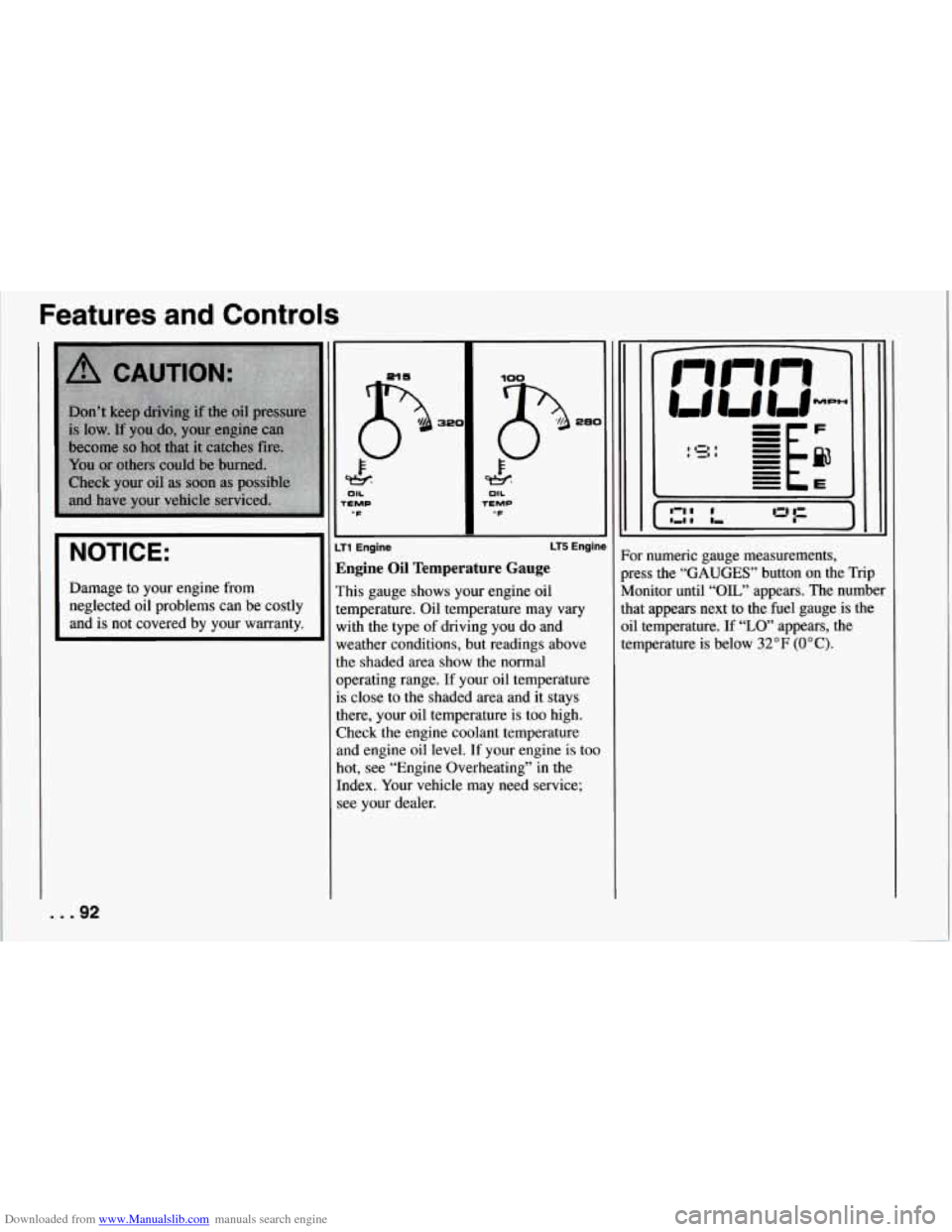
Downloaded from www.Manualslib.com manuals search engine Features and Controls
I NOTICE:
I
Damage to your engine from
neglected oil problems can be costly
and is not covered by your warranty.
... 92
TEMP OIL
OF TEMP OIL
‘F
280
T1 Engine LT5 Enginl
Zngine Oil Temperature Gauge
rhis gauge shows your engine oil
emperature. Oil temperature may
vary
vith the type of driving you do and
weather conditions, but readings above
the shaded area show the normal
operating range. If your oil temperature
is close to the shaded area and it stays
there, your oil temperature is too high.
Check the engine coolant temperature
and engine oil level. If your engine
is too
hot, see “Engine Overheating” in the
Index. Your vehicle may need service;
see your dealer.
1 IZI I
I ,I I
)r numeric gauge measurements,
ness the
“GAUGES” button on the Trip
[onitor until
“OIL” appears. The number
at appears next to the fuel gauge is the
1 temperature. If “LO’ appears, the
mperature
is below 32°F (OOC).
Page 94 of 274
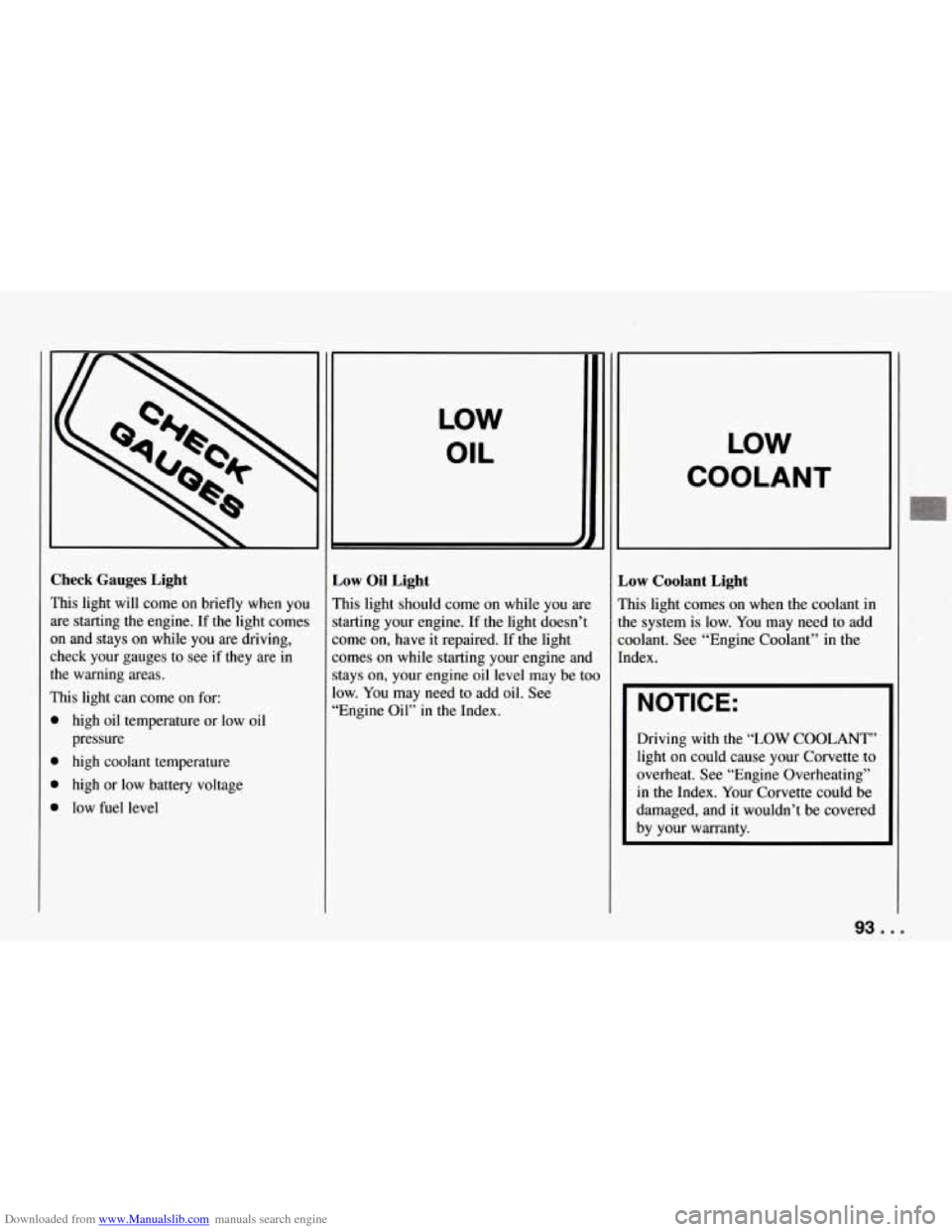
Downloaded from www.Manualslib.com manuals search engine Check Gauges Light
This light will come on briefly when you are starting
the engine. If the light comes
on and stays on while you are driving,
check your gauges to see if they are in
the warning areas.
This light can come on for:
high oil temperature or low oil
pressure
high coolant temperature
high or low battery voltage
low fuel level
LOW
OIL
L
Low Oil Light
This light should come on while you are
starting your engine. If
the light doesn’t
come on, have it repaired.
If the light
comes on while starting your engine and
stays on, your engine oil level may be too
low. You may need to add oil. See
“Engine Oil” in the Index.
LOW
COOLANT
Low Coolant Light
This light comes on when the coolant in
the system is low. You may need to add
coolant. See “Engine Coolant” in the
Index.
NOTICE:
Driving with the “LOW COOLANT”
light on could cause your Corvette to
overheat. See “Engine Overheating”
in the Index. Your Corvette could be
damaged, and it wouldn’t be covered
by your warranty.
93 ...
Page 107 of 274
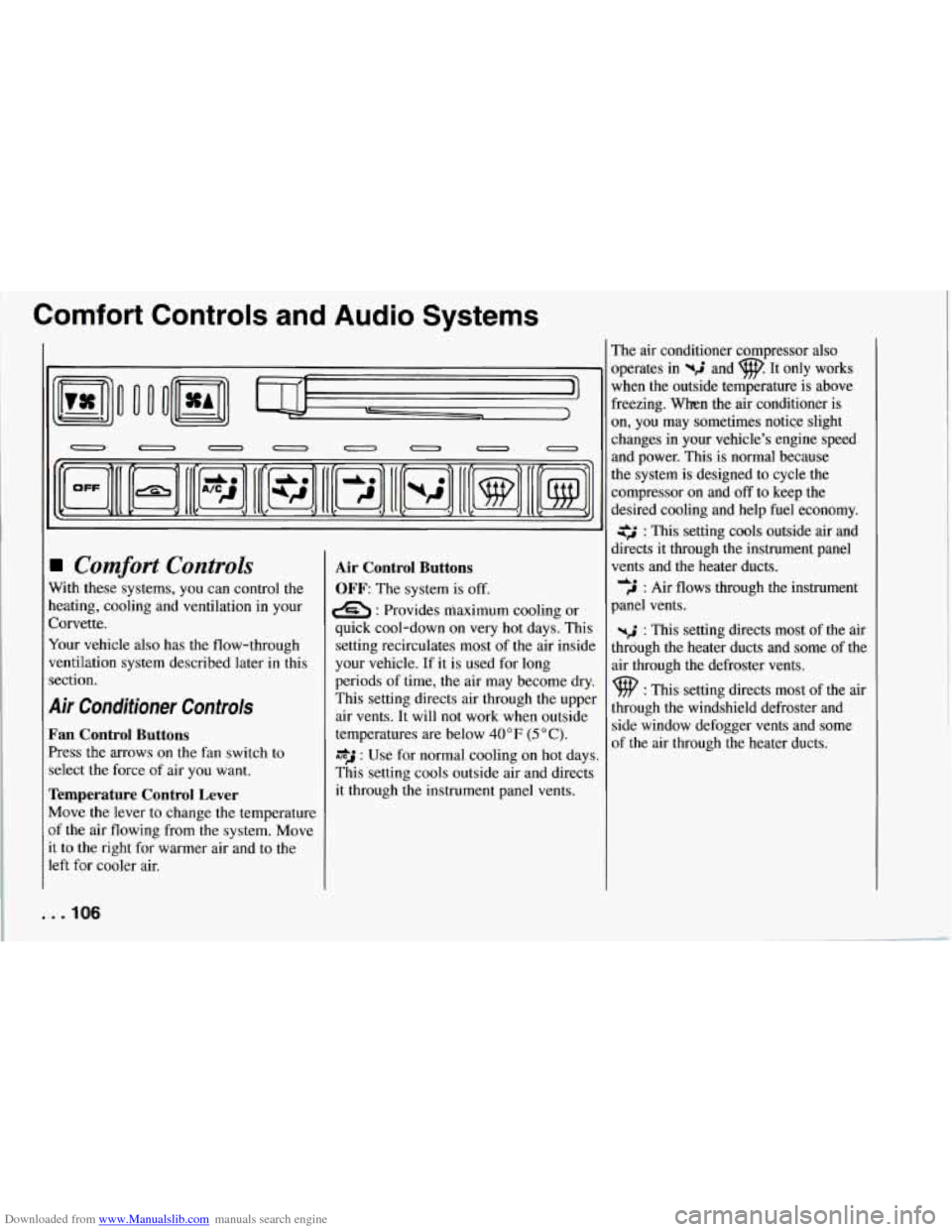
Downloaded from www.Manualslib.com manuals search engine Comfort Controls and Audio Systems
0 00
0 0 0 0 0 0 0 a
Comfort Controls
With these systems, you can control the
heating, cooling and ventilation in your
Corvette.
Your vehicle also has
the flow-through
ventilation system described later in this
section.
Air Conditioner Controls
Fan Control Buttons
Press the arrows on the fan switch to
select the force of air you want.
Temperature Control Lever
Move the lever to change the temperature
of the air flowing from
the system. Move
it to the right for warmer air and to the
left for cooler air.
Air Control Buttons
OFF: The system is off.
e : Provides maximum cooling or
quick cool-down on very hot days. This
setting recirculates most of the air inside
your vehicle. If it is used for long
periods of time,
the air may become dry.
This setting directs air through the upper
air vents. It will not work when outside
temperatures are below
40 OF (5 O C).
*J : Use for normal cooling on hot days.
This setting cools outside air and directs
it through the instrument panel vents. The air conditioner compressor also
operates in
%$ and w. It only works
when the outside temperature is above
freezing. When the air conditioner is
on, you may sometimes notice slight
changes
in your vehicle’s engine speed
and power. This is normal because
the system is designed to cycle the
compressor on and
off to keep the
desired cooling and help fuel economy.
: This setting cools outside air and
directs it through the instrument panel
vents and the heater ducts.
,J : Air flows through the instrument
panel vents.
-2 : This setting directs most of the air
through the heater ducts and some of the
air through the defroster vents.
9 : This setting directs most of the air
through the windshield defroster and
side window defogger vents and some
of the air through the heater ducts.
de
. . .IO6
Page 108 of 274
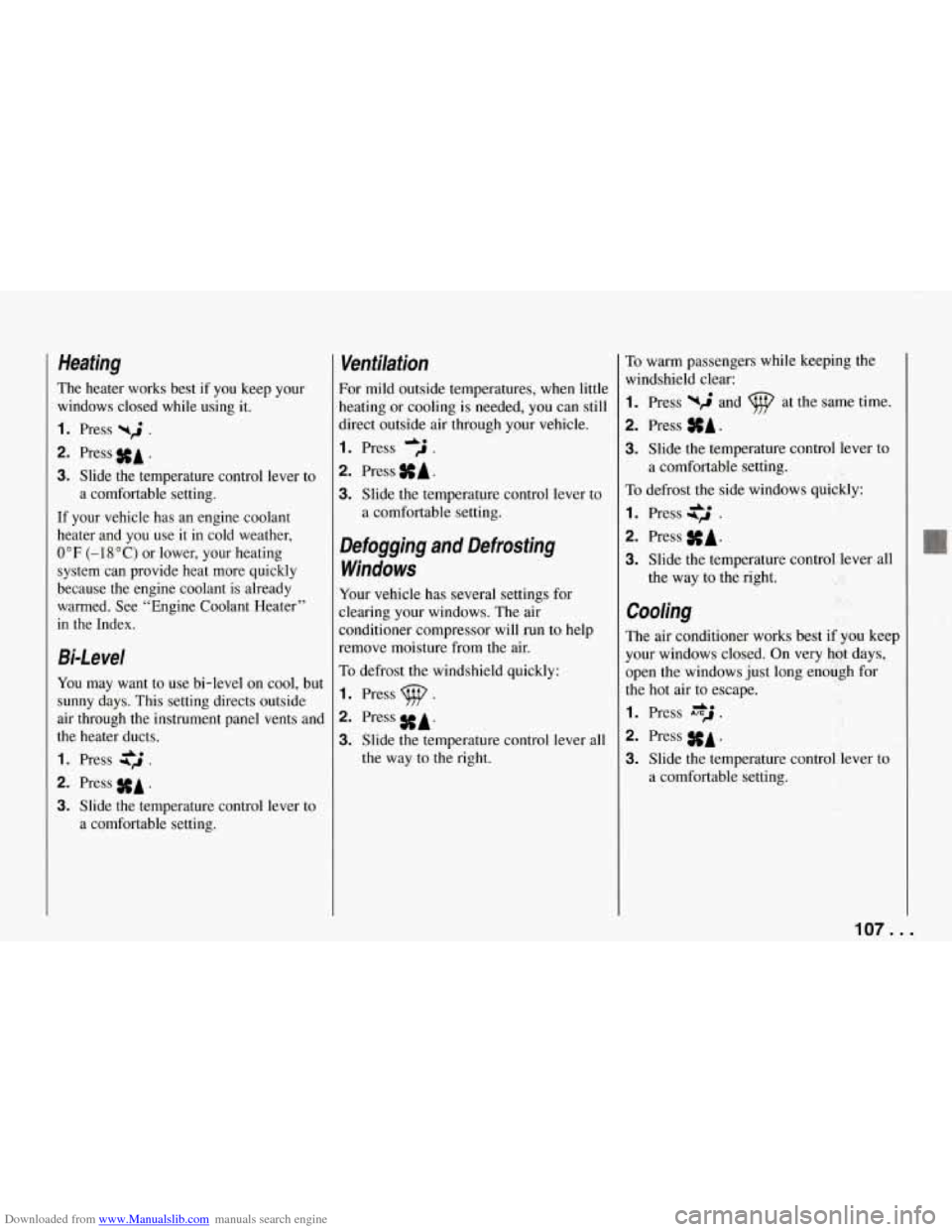
Downloaded from www.Manualslib.com manuals search engine Heating
The heater works best if you keep your
windows closed while using it.
1. Press yri .
2. Press #A .
3. Slide the temperature control lever to
If your vehicle has an engine coolant
heater and you use it in cold weather,
0°F (-18°C) or lower, your heating
system can provide heat more quickly
because the engine coolant is already
warmed. See “Engine Coolant Heater”
in the Index. a comfortable setting.
Bi-Level
You may want
to use bi-level on cool, but
sunny days. This setting directs outside
air through the instrument panel vents and
the heater ducts.
1. Press $2 .
2. Press #A .
3. Slide the temperature control lever to
a comfortable setting.
Ventilation
For mild outside temperatures, when little
heating or cooling is needed, you can still
direct outside air through your vehicle.
I. Press .
2. Press SA.
3. Slide the temperature control lever to
a comfortable setting.
Defogging and Defrosting
Windows
Your vehicle has several settings for
Aearing your windows. The air
Zonditioner compressor will
run to help
remove moisture from the air.
To defrost the windshield quickly:
I. Press p .
2. Press SA.
3. Slide the temperature control lever all
the way to the right.
To warm passengers while keeping the
windshield clear:
1. Press wd and at the same time.
2. Press SA.
3. Slide the temperature control lever to
To defrost the side windows quickly:
I. Press .
2. Press SA.
3. Slide the temperature control lever all
a
comfortable setting.
the way to the right.
Cooling
The air conditioner works best if you keep
your windows closed. On very hot days,
,pen the windows just long enou,gh for
:he hot air to escape.
I. Press A*J .
2. Press SA.
3. Slide the temperature control lever to
a comfortable setting.
107. I
Page 110 of 274
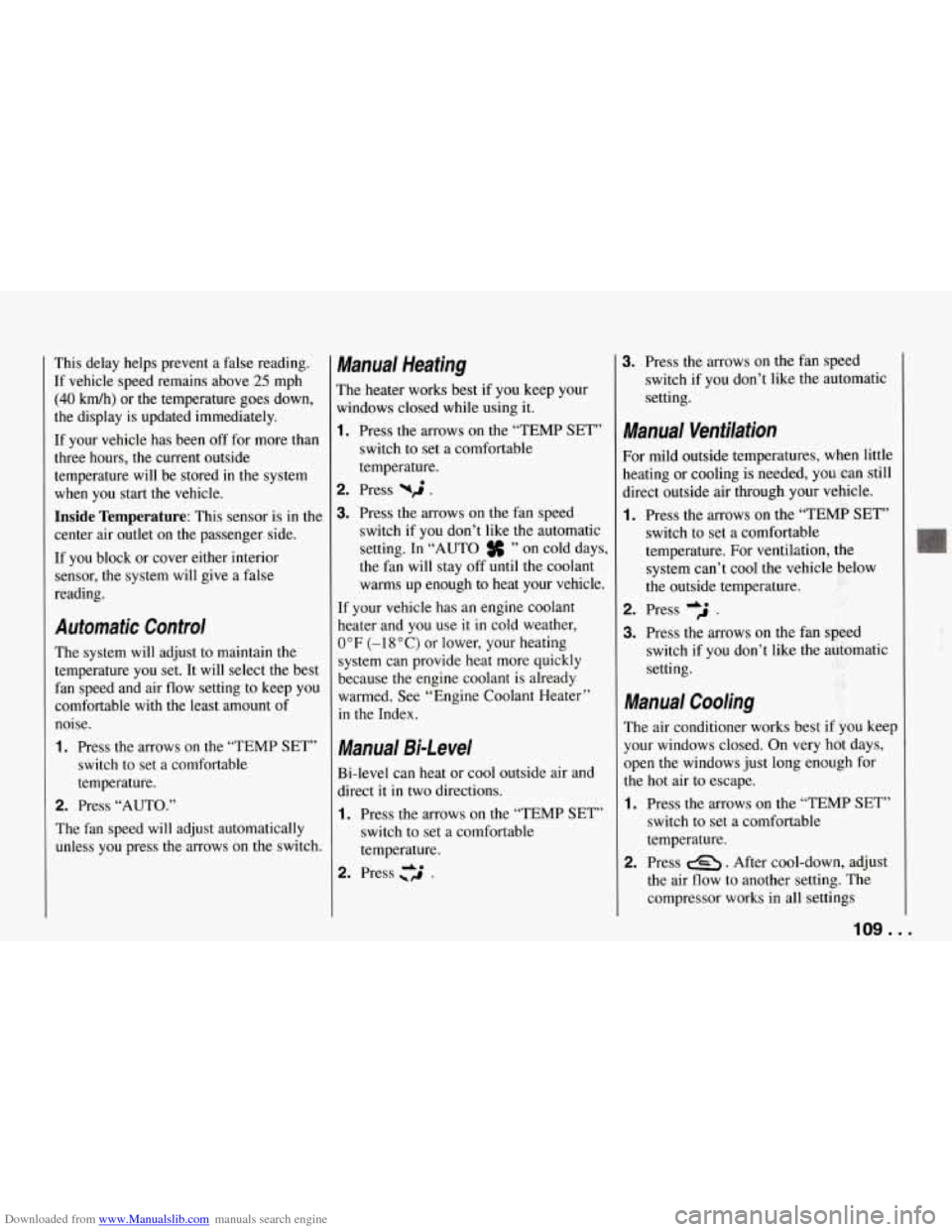
Downloaded from www.Manualslib.com manuals search engine This delay helps prevent a false reading.
If vehicle speed remains above
25 mph
(40 kmh) or the temperature goes down,
the display is updated immediately.
If your vehicle has been
off for more than
three hours, the current outside
temperature will be stored
in the system
when you start the vehicle.
Inside Temperature: This sensor is in the
center air outlet on the passenger side.
If you block or cover either interior
sensor, the system will give a false
reading.
Automatic Control
The system will adjust to maintain the
temperature you set. It will select the best
fan speed and air flow setting to keep you
comfortable with the least amount of
noise.
1. Press the arrows on the “TEMP SET”
switch to set a comfortable
temperature.
2. Press “AUTO.”
The fan speed will adjust automatically unless you press
the arrows on the switch.
Manual Heating
The heater works best if you keep your
windows closed while using it.
1. Press the arrows on the “TEMP SET”
switch to set a comfortable
temperature.
2. Press uj .
3. Press the arrows on the fan speed
switch if you don’t like the automatic
setting. In “AUTO
# ” on cold days,
the fan will stay off until the coolant
warms up enough to heat your vehicle.
If your vehicle has an engine coolant
heater and you use it in cold weather,
0 OF (-1 8 O C) or lower, your heating
system can provide heat more quickly
because the engine coolant
is already
warmed. See “Engine Coolant Heater”
in the Index.
Manual Bi-Level
Bi-level can heat or cool outside air and
direct it in two directions.
1. Press the arrows on the “TEMP SET”
switch to set a comfortable
temperature.
2. Press 3 .
3. Press the arrows on the fan speed
switch if
you don’t like the automatic
setting.
Manual Ventilation
For mild outside temperatures, when little
heating or cooling is needed, you can still
direct outside
air through your vehicle.
1. Press the arrows on the “TEMP SET”
switch to set a comfortable
temperature. For ventilation, the system can’t cool the vehicle below
the outside temperature.
2. Press dJ .
3. Press the arrows on the fan speed
switch if you don’t like the automatic
setting.
Manual Cooling
The air conditioner works best if you keep
your windows closed. On very hat days,
open the windows just long enough for
the hot air to escape.
1. Press the arrows on the “TEMP SET”
switch to set a comfortable
temperature.
2. Press a. After cool-down, adjust
the air flow to another setting. The
compressor works in all settings
109 ...
Page 142 of 274
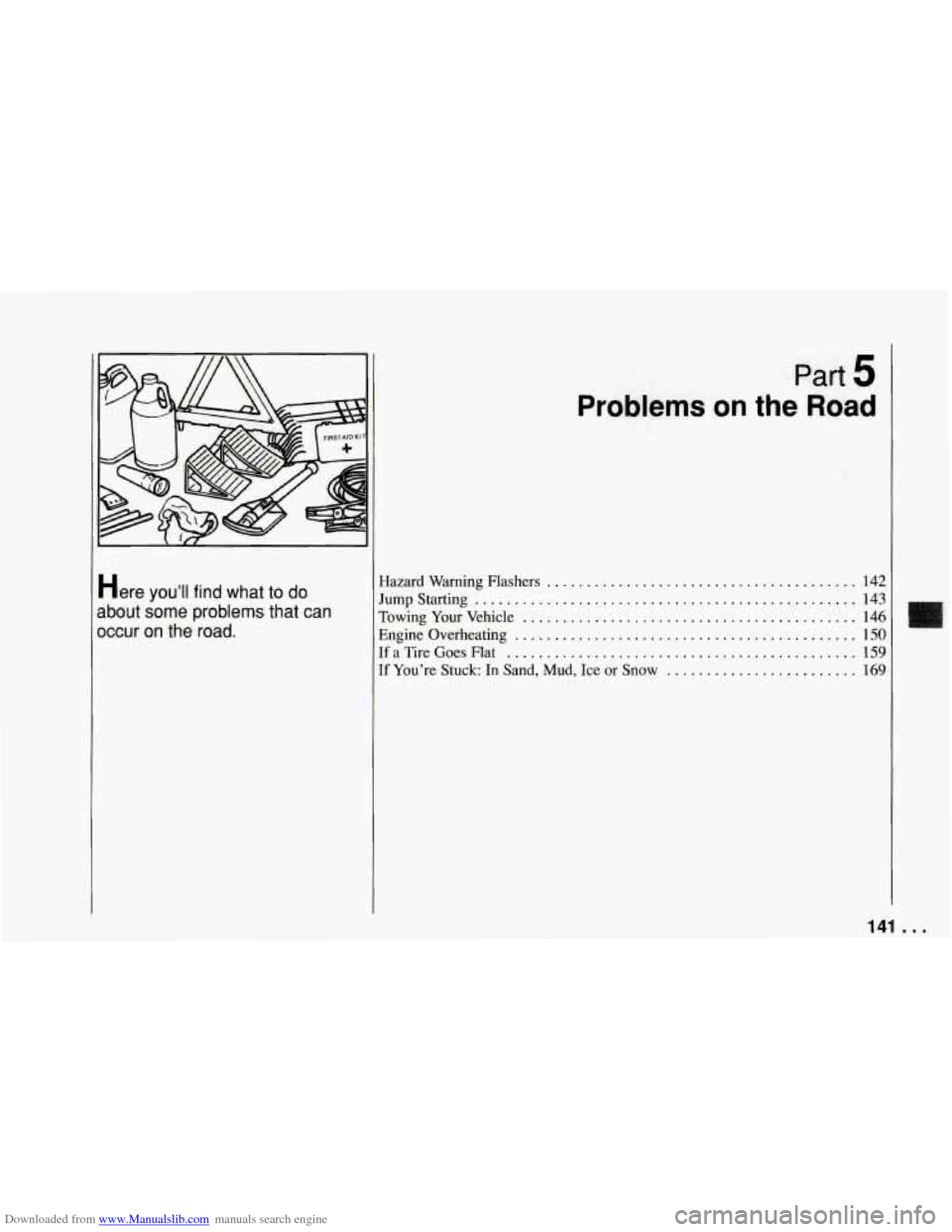
Downloaded from www.Manualslib.com manuals search engine Here you’tl find what to do
about some problems that can
occur on the road
.
Part 5
Problems on the Road
Hazard Warning Flashers ....................................... 142
rumpStarting ................................................ 143
rowing Your Vehicle
.......................................... 146
Engine Overheating ........................................... 150
[f a Tire Goes Flat ............................................ 159
[f You’re Stuck: In Sand. Mud. Ice or Snow ........................ 169
141 ...
Page 151 of 274
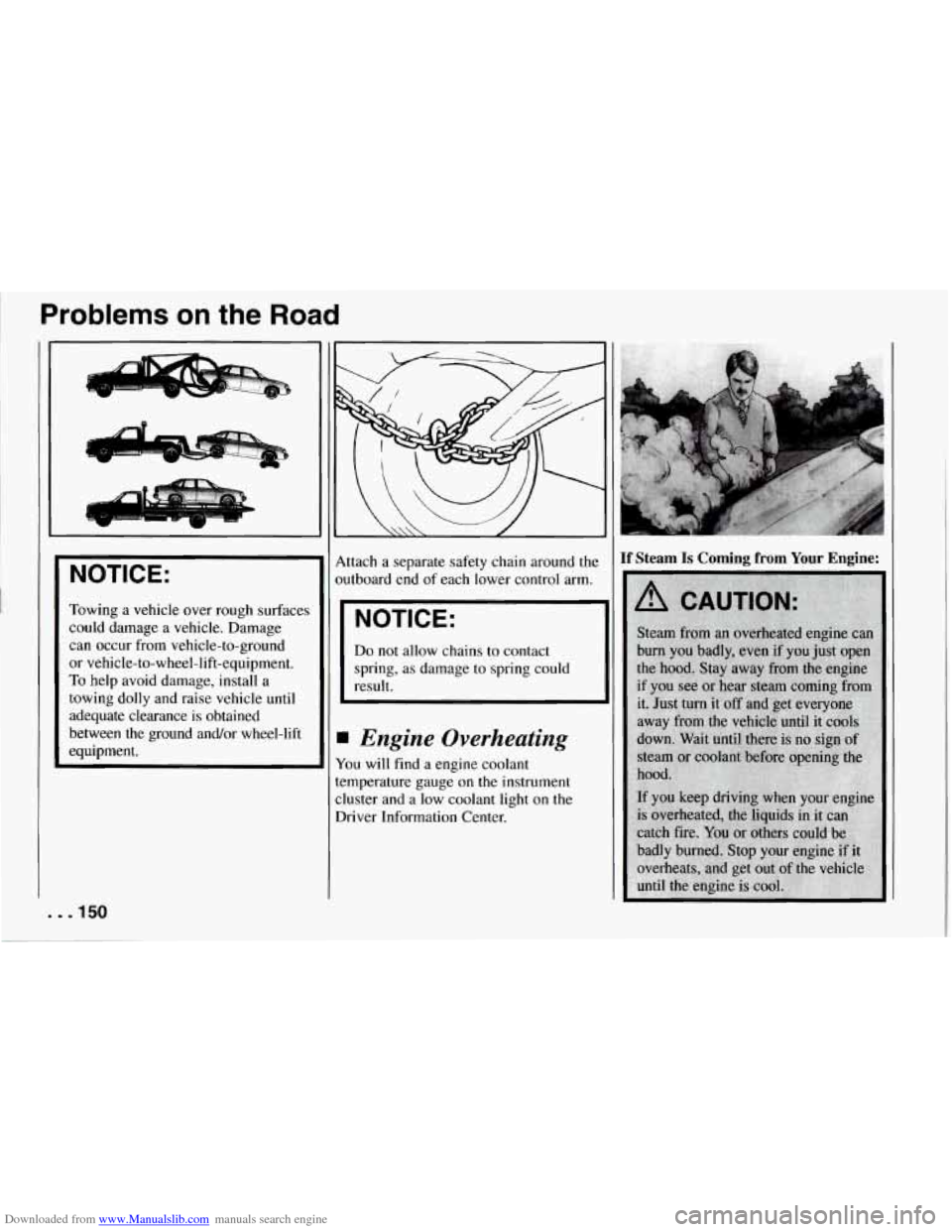
Downloaded from www.Manualslib.com manuals search engine Problems on the Road
NOTICE:
Towing a vehicle over rough surfaces
could damage a vehicle. Damage
can occur from vehicle-to-ground
or vehicle-to-wheel-lift-equipment.
To help avoid damage, install a
towing dolly and raise vehicle until
adequate clearance
is obtained
between the ground and/or wheel-lift
equipment. Attach
a separate safety chain around the
outboard end of each lower control
arm.
NOTICE:
Do not allow chains to contact
spring, as damage to spring could
result.
Engine Overheating
You will find a engine coolant
temperature gauge on the instrument
cluster and a low coolant light on the
Driver Information Center.
If Steam Is Corning from Your Engine:
. . .I50